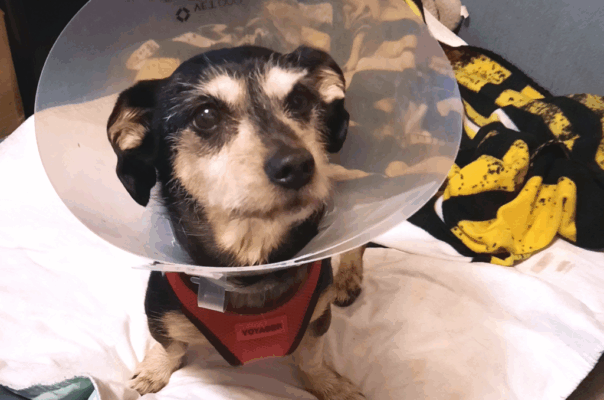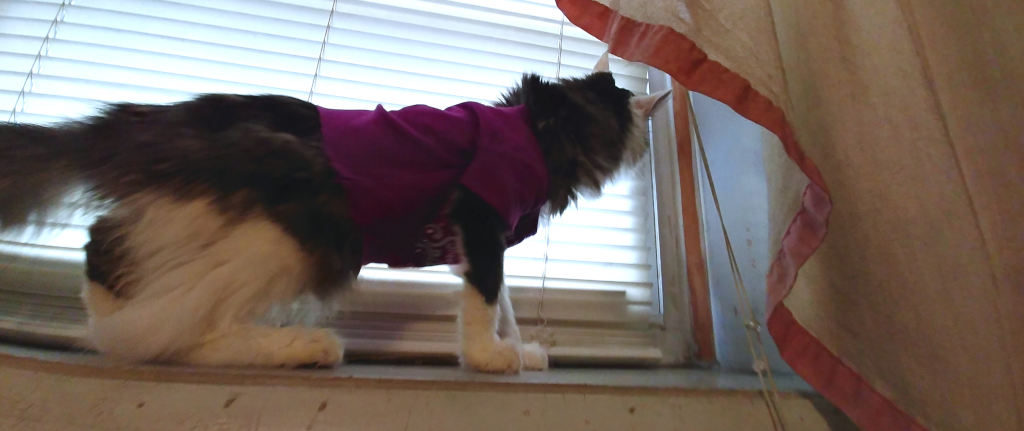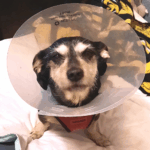 When our beloved pets require veterinary care, whether for routine procedures, injuries, or ongoing conditions, they often come home needing special attention. One crucial aspect of at-home recovery is preventing pets from interfering with their healing process.
When our beloved pets require veterinary care, whether for routine procedures, injuries, or ongoing conditions, they often come home needing special attention. One crucial aspect of at-home recovery is preventing pets from interfering with their healing process.
This is where protective recovery devices come into play – tools that can make the difference between a smooth recovery and a series of setbacks. Everything from the standard cone to the full on recovery suit.
The Importance of Recovery Devices
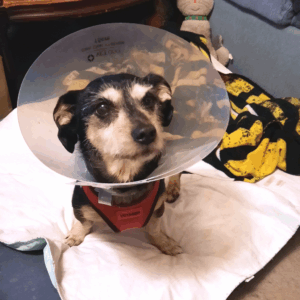 Any pet owner who has watched their furry companion struggle with a cone or protective device knows the heartache of seeing them uncomfortable. However, these devices serve a vital purpose: they prevent pets from licking, scratching, or biting at wounds, stitches, or irritated areas. Without such protection, pets can quickly undo veterinary work, introduce infections, or worsen existing conditions.
Any pet owner who has watched their furry companion struggle with a cone or protective device knows the heartache of seeing them uncomfortable. However, these devices serve a vital purpose: they prevent pets from licking, scratching, or biting at wounds, stitches, or irritated areas. Without such protection, pets can quickly undo veterinary work, introduce infections, or worsen existing conditions.
The right recovery device can:
- Prevent self-trauma to healing areas
- Reduce the risk of infection
- Allow medications to work effectively
- Provide comfort during the healing process
- Give pet owners peace of mind
Jack’s Journey: From Trauma to Recovery
The Husky Attack and the Inflatable Neck Pillow
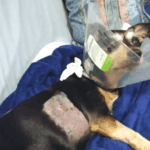 Jack, a spirited Jack Russell Terrier, faced a traumatic experience when he was attacked by two loose huskies. The incident left him with injuries requiring immediate veterinary attention. After treatment, Jack came home with a soft, traditional cone for his own protection. We eventually switched him to an inflatable neck pillow as he was having too much of an issue in his daily routine and he had injuries on his neck that we wanted to keep clear of the cone.
Jack, a spirited Jack Russell Terrier, faced a traumatic experience when he was attacked by two loose huskies. The incident left him with injuries requiring immediate veterinary attention. After treatment, Jack came home with a soft, traditional cone for his own protection. We eventually switched him to an inflatable neck pillow as he was having too much of an issue in his daily routine and he had injuries on his neck that we wanted to keep clear of the cone.
The inflatable neck pillow, sometimes called a recovery collar or donut, works by restricting a dog’s neck movement without blocking peripheral vision. For Jack, this meant he couldn’t reach his wounds to lick or scratch them, but he maintained his dignity and most of his normal functions.
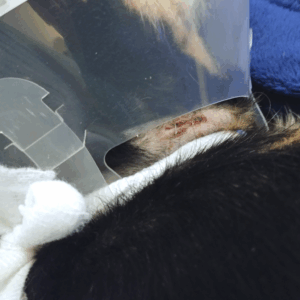 The benefits of the inflatable pillow for Jack included:
The benefits of the inflatable pillow for Jack included:
- Comfort: Unlike rigid cones, the pillow was soft and served as a cushion when he rested his head.
- Mobility: Jack could navigate his environment more easily than with a cone, which often catches on doorways, furniture, and other objects.
- Mental well-being: The less restrictive nature of the pillow reduced the stress and depression that often accompanies recovery devices.
- Eating and drinking: Jack could access his food and water bowls without the awkward positioning required with a cone.
Despite these advantages, the pillow required monitoring to ensure it remained properly inflated and positioned. It was also important to check that Jack couldn’t maneuver around it to reach his injuries.
The Cone of Shame: Post-Neutering Recovery
Later in life, when Jack was adopted from the ASPCA, he had been recently neutered despite his senior status. This procedure, while routine, can be more traumatic for older dogs whose bodies have fully developed. Jack came home with the traditional Elizabethan collar, commonly known as the “cone of shame.”
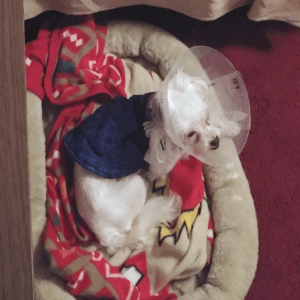 The cone created a physical barrier that completely prevented Jack from reaching his surgical site. We also had some surgery for our senior dog Sophie. She had some mammary tumors that needed to be removed. While effective, the cone comes with challenges:
The cone created a physical barrier that completely prevented Jack from reaching his surgical site. We also had some surgery for our senior dog Sophie. She had some mammary tumors that needed to be removed. While effective, the cone comes with challenges:
- Limited vision: The cone restricted Sophie’s peripheral vision, making her more anxious and prone to bumping into objects.
- Difficulty eating and drinking: The cone’s rigid structure complicated access to food and water bowls.
- Sleep disruption: Finding a comfortable sleeping position proved challenging with the cone in place.
- Noise and sensory issues: The plastic material amplified sounds and created an echo chamber, adding to Sophie’s discomfort.
- Social impact: The cone altered Sophie’s ability to communicate normally with humans and other pets through body language.
Despite these drawbacks, the cone provided absolute protection for her surgical site, which was crucial for proper healing. For senior dogs like Sohie, proper healing is especially important as their recovery can take longer than younger animals. Sophie didn’t seem eligible for the inflatable donut we has as she is a rather small dog.
Bubbles’ Story: Managing Compulsive Fur-Pulling
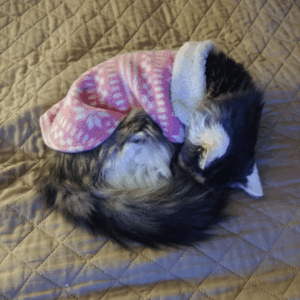 Bubbles, an aging cat, developed a concerning habit of pulling out her fur. Despite veterinary examinations ruling out common skin conditions, her self-destructive behavior continued. The solution came in the form of a specially designed jumpsuit or bodysuit for cats.
Bubbles, an aging cat, developed a concerning habit of pulling out her fur. Despite veterinary examinations ruling out common skin conditions, her self-destructive behavior continued. The solution came in the form of a specially designed jumpsuit or bodysuit for cats.
The recovery suit offered a different approach to protection:
- Full coverage: Unlike cones or pillows that restrict access, the suit physically covered the affected areas.
- Natural movement: Bubbles could move, eat, use the litter box, and groom unaffected areas normally.
- Psychological comfort: The gentle pressure of the suit may have provided anxiety relief, similar to how pressure vests work for some pets.
- Warmth: As an elderly cat, Bubbles benefited from the additional warmth the suit provided.
Initially resistant to the suit, Bubbles eventually adapted and seemed to appreciate its benefits. This highlights an important aspect of recovery devices: pets often need time to adjust, and patience from owners is essential during this period.
Recovery Device Options: Finding the Right Fit
Traditional Elizabethan Collars (E-Collars/Cones)
The most recognized recovery device, the cone comes in various materials:
- Plastic cones: Durable and effective, but often uncomfortable and distressing for pets.
- Soft fabric cones: More comfortable and less noisy, though sometimes less rigid and effective.
- Clear plastic cones: Reduce visual impairment while maintaining protection.
Cones are typically best for:
- Post-surgical recovery, especially abdominal procedures
- Preventing access to ears, eyes, and face
- Short-term intensive protection
Inflatable Collars
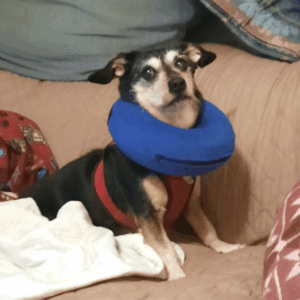 As seen with Jack’s first recovery experience, inflatable collars offer:
As seen with Jack’s first recovery experience, inflatable collars offer:
- Better peripheral vision
- Improved comfort for sleeping and resting
- Easier eating and drinking
- Less household disruption (no bumping into furniture)
These work well for:
- Wounds on the body or limbs
- Pets who become extremely stressed with traditional cones
- Longer recovery periods where comfort is a priority
Recovery Bodysuits/Jumpsuits
Like what helped Bubbles, bodysuits provide:
- Coverage of large areas of the body
- Freedom of movement and vision
- No restriction on eating, drinking, or using the bathroom (when properly designed)
- Additional warmth for older pets
These are ideal for:
- Skin conditions covering large areas
- Preventing excessive grooming or fur-pulling
- Protecting multiple wound sites
- Pets who become distressed by head-based devices
Alternative Options
Beyond these common solutions, other options include:
- Recovery sleeves/leggings: For isolated limb injuries
- Neck brace alternatives: Structured like a firm collar but less restrictive than a cone
- Surgical recovery shirts: Similar to bodysuits but specifically designed for abdominal surgeries
- DIY solutions: Carefully modified baby clothes or shirts (under veterinary guidance)
Choosing the Right Device for Your Pet
Selecting the appropriate recovery device involves several considerations:
- Location of injury or condition: Different devices work better for specific body areas.
- Your pet’s temperament: Some pets tolerate certain devices better than others.
- Length of recovery: More comfortable options might be worth the investment for longer healing periods.
- Home environment: Consider how the device will impact your pet’s ability to navigate stairs, pet doors, etc.
- Monitoring capabilities: Some devices require more frequent checking and adjustment.
Always consult with your veterinarian before making a final decision. They can provide guidance based on your specific pet’s needs and the nature of their condition.
Making Recovery More Comfortable: Tips for Pet Owners
Beyond choosing the right device, there are ways to make the recovery process easier:
- Modify your home: Create clear pathways, raise food and water dishes if necessary, and remove obstacles.
- Establish a safe space: Set up a comfortable recovery area with familiar bedding and toys.
- Provide distraction: Use puzzle toys, gentle play, or companionship to keep your pet’s mind off the device.
- Monitor for issues: Check regularly for signs of discomfort, device failure, or healing problems.
- Offer positive reinforcement: Reward your pet for tolerating the device rather than punishing attempts to remove it.
- Consider alternatives: Rotate between different device types if appropriate and approved by your vet.
- Maintain cleanliness: Regularly clean both the device and affected areas to prevent infection or irritation.
The Emotional Aspect of Recovery
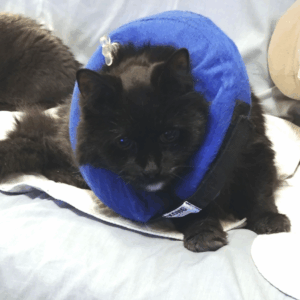 The psychological impact of recovery devices shouldn’t be underestimated. Many pets experience:
The psychological impact of recovery devices shouldn’t be underestimated. Many pets experience:
- Depression or lethargy
- Increased anxiety
- Changes in behavior
- Reluctance to engage in normal activities
As owners, providing extra attention, reassurance, and patience can make a significant difference. Remember that your pet doesn’t understand why they’re wearing this strange device, only that it’s uncomfortable and limiting.
When to Contact Your Veterinarian
While recovery devices are generally safe when properly fitted and monitored, watch for:
- Signs of device-related injuries (chafing, pressure sores)
- Excessive stress or panic
- Inability to eat, drink, or eliminate normally
- Signs of the original condition worsening
- Device damage or failure
Don’t hesitate to contact your veterinarian if you notice any of these issues or if you’re concerned about your pet’s recovery progress.
Conclusion: The Benefits of Proper Recovery Management
As demonstrated by both Jack, Sophie and Bubbles’ experiences, the right recovery device can make a significant difference in healing outcomes. While these devices may cause temporary discomfort or adjustment issues, they prevent the far more serious consequences of interrupted healing.
For pet owners, understanding and properly implementing recovery devices offers peace of mind. Knowing your pet cannot access their wound or condition allows you to relax rather than maintaining constant vigilance.
The investment in appropriate recovery tools – whether a specialized cone, inflatable collar, or body suit – is ultimately an investment in your pet’s well-being and your relationship with them. A smoother recovery process means returning more quickly to the healthy, happy companionship that makes pet ownership so rewarding.
Remember that each pet is unique, and what worked well for Jack or Bubbles might not be ideal for your companion. Work closely with your veterinary team, observe your pet carefully, and be willing to adjust your approach to find the solution that provides both protection and comfort during this vulnerable time.


